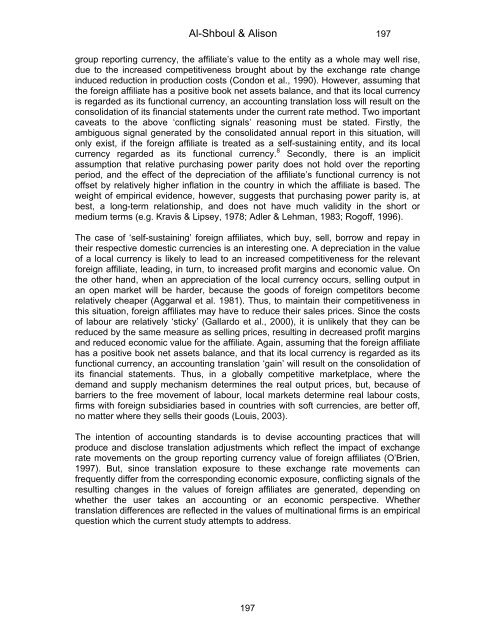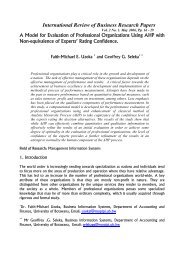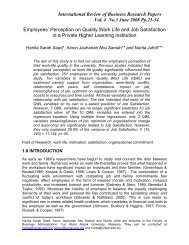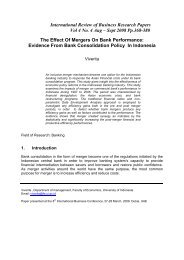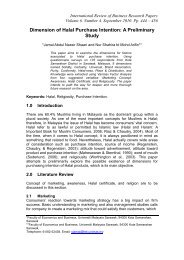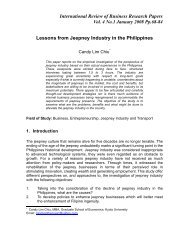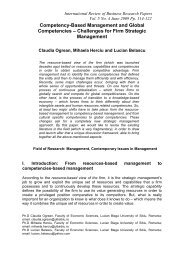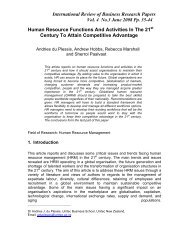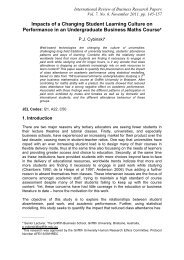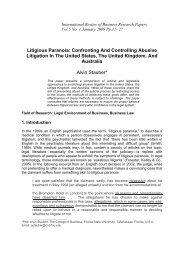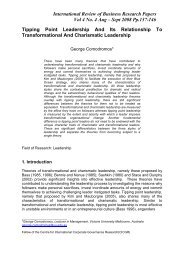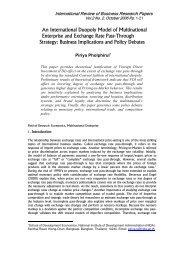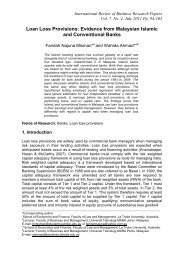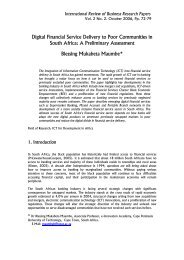Translation Exposure and Firm Value, Evidence From Australian ...
Translation Exposure and Firm Value, Evidence From Australian ...
Translation Exposure and Firm Value, Evidence From Australian ...
You also want an ePaper? Increase the reach of your titles
YUMPU automatically turns print PDFs into web optimized ePapers that Google loves.
Al-Shboul & Alison 197group reporting currency, the affiliate’s value to the entity as a whole may well rise,due to the increased competitiveness brought about by the exchange rate changeinduced reduction in production costs (Condon et al., 1990). However, assuming thatthe foreign affiliate has a positive book net assets balance, <strong>and</strong> that its local currencyis regarded as its functional currency, an accounting translation loss will result on theconsolidation of its financial statements under the current rate method. Two importantcaveats to the above ‘conflicting signals’ reasoning must be stated. Firstly, theambiguous signal generated by the consolidated annual report in this situation, willonly exist, if the foreign affiliate is treated as a self-sustaining entity, <strong>and</strong> its localcurrency regarded as its functional currency. 8 Secondly, there is an implicitassumption that relative purchasing power parity does not hold over the reportingperiod, <strong>and</strong> the effect of the depreciation of the affiliate’s functional currency is notoffset by relatively higher inflation in the country in which the affiliate is based. Theweight of empirical evidence, however, suggests that purchasing power parity is, atbest, a long-term relationship, <strong>and</strong> does not have much validity in the short ormedium terms (e.g. Kravis & Lipsey, 1978; Adler & Lehman, 1983; Rogoff, 1996).The case of ‘self-sustaining’ foreign affiliates, which buy, sell, borrow <strong>and</strong> repay intheir respective domestic currencies is an interesting one. A depreciation in the valueof a local currency is likely to lead to an increased competitiveness for the relevantforeign affiliate, leading, in turn, to increased profit margins <strong>and</strong> economic value. Onthe other h<strong>and</strong>, when an appreciation of the local currency occurs, selling output inan open market will be harder, because the goods of foreign competitors becomerelatively cheaper (Aggarwal et al. 1981). Thus, to maintain their competitiveness inthis situation, foreign affiliates may have to reduce their sales prices. Since the costsof labour are relatively ‘sticky’ (Gallardo et al., 2000), it is unlikely that they can bereduced by the same measure as selling prices, resulting in decreased profit margins<strong>and</strong> reduced economic value for the affiliate. Again, assuming that the foreign affiliatehas a positive book net assets balance, <strong>and</strong> that its local currency is regarded as itsfunctional currency, an accounting translation ‘gain’ will result on the consolidation ofits financial statements. Thus, in a globally competitive marketplace, where thedem<strong>and</strong> <strong>and</strong> supply mechanism determines the real output prices, but, because ofbarriers to the free movement of labour, local markets determine real labour costs,firms with foreign subsidiaries based in countries with soft currencies, are better off,no matter where they sells their goods (Louis, 2003).The intention of accounting st<strong>and</strong>ards is to devise accounting practices that willproduce <strong>and</strong> disclose translation adjustments which reflect the impact of exchangerate movements on the group reporting currency value of foreign affiliates (O’Brien,1997). But, since translation exposure to these exchange rate movements canfrequently differ from the corresponding economic exposure, conflicting signals of theresulting changes in the values of foreign affiliates are generated, depending onwhether the user takes an accounting or an economic perspective. Whethertranslation differences are reflected in the values of multinational firms is an empiricalquestion which the current study attempts to address.197


